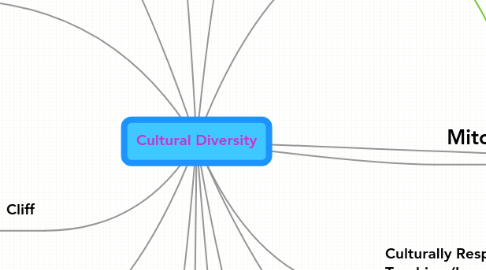
1. Cliff
1.1. Awareness
1.2. Sensitivity
1.3. Student Safety (free to express)
1.4. integrity
1.5. Balance
2. Bonnie thinks...
2.1. diversity
2.1.1. open acceptance
2.2. division
2.2.1. silent tolerance
2.2.2. rules of accomodation
2.2.3. domineering and dominating cultures
2.2.4. parity not equality
2.3. Tribes of of MeWe~i
2.3.1. collective collaboration on line
2.3.1.1. not just connections
2.3.2. gauntlets
2.3.2.1. language
2.3.2.1.1. ie: physics forums
2.3.2.2. history
2.3.2.3. cyber land/address
2.3.3. who
2.3.3.1. users (i) belong to mutiple tribes
2.3.3.2. earned acceptance
3. Melting Pot ( Justin)
3.1. similiar differences
3.2. shared community
3.2.1. meritocracy
3.2.2. division of labour
3.3. accepted behaviours
4. Donna adds - cultural customs
4.1. communication
4.1.1. frequency of contact
4.2. family units/extended family
5. Johneen
5.1. Understanding based on...
5.1.1. Family Traditions
5.1.2. Personal Experience
5.1.3. Education in Country of Residence
5.1.4. Personal Belief System
5.1.5. Way of Communicating Beliefs
5.1.5.1. language
5.1.5.2. writing
5.1.5.3. listening style
5.1.5.4. Social rules/ etiquette
6. Charmaine thinks
6.1. Immigrating Students may feel the following:
6.2. An inequality in education
6.3. Personal Attitudes are judged
6.4. Lack of cultural awareness in the learning environment
7. Tracey
7.1. Communication
7.1.1. Non-verbal Communication
7.1.2. Socialized gestures and sounds
7.1.3. Written and Oral Skill Level
7.1.4. Facial expressions
7.2. Perspectives
7.2.1. Preconceived notions
7.2.2. Attitudes
7.2.3. Beliefs
7.2.4. Background and past experience
7.3. Tools
7.3.1. Access to technology and other tools
7.3.2. Emphasis and encouragement of use
7.3.3. Guidance and support
8. Mitch
8.1. Expressions & Metaphors
8.2. .
8.3. Technology Uses/ Comfort
9. JAMES
9.1. ethnicity
9.1.1. country
9.1.2. continent
9.2. generational
9.2.1. youth
9.2.2. mid-life
9.2.3. advanced
9.3. social
9.3.1. religion
9.3.1.1. myths of creation
9.3.2. mental
9.3.3. emotional
9.4. economy
9.4.1. external
9.4.2. personal
9.5. technology
9.5.1. access
9.5.2. cost
9.5.3. ubiquity
9.6. language
9.6.1. writing
9.6.2. reading
9.7. physical
10. Culturally Responsive Teaching (Laurette)
10.1. differentiating instruction
10.1.1. cultural backgrounds
10.1.2. learning styles
10.2. ESL immigrant population collision: haves vs have nots (Tapscott, 1987)
10.3. learner-centredness
10.3.1. cultural construct
10.3.2. stakeholder centredness
10.4. age, gender & cultural issues (Moller, 2005)
10.5. second language learning: written, reading & visual
10.6. technology enhancement
11. Multi-dimensional (Vicki)
11.1. learning styles
11.1.1. Myers-Briggs
11.1.2. Multiple Intelligences
11.2. cultural
11.3. communication
11.4. technology
12. Mitch
13. Karen
13.1. compassion
13.2. empathy
13.3. embracing
13.4. awareness
14. ian
14.1. multi-cultural learning environments...
14.1.1. need to be aware of prior knowledge and learning experiences; backgrounds.
14.1.1.1. need to be aware of the traditional ways of communicating
14.1.1.1.1. need to be aware of possible language barriers
15. Erin
15.1. ethnocentrism
15.1.1. Overlooking differences
15.1.1.1. Common human error
15.2. Equal opportunity
15.2.1. recognizing similarities & differences
15.2.1.1. goals
15.2.1.2. values
15.2.1.3. Beliefs
15.2.1.4. Outcomes
